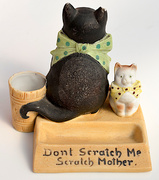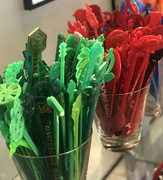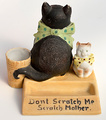
Scott Thompson with a small portion of his metallic menagerie and a few of his trunks.
Scott Thompson has a lot of dogs, somewhere in the neighborhood of 40 or more. With the exception of one dachshund that scampers around his home, Thompson’s canine companions have never been heard to bark, owing to the fact that they are made out of cast iron, aluminum, brass, or bronze. Accordingly, Thompson’s dogs tend to be heavy, weighing upwards of 18 pounds apiece, but weight is a key requirement for dogs trained to hold doors open or keep a shelf full of books from tumbling onto the floor. Save that one real live dachshund, that’s exactly what most of Thompson’s dogs were designed to do.
“We had a pair of red mules on our farm. Neither of them had a name.”
Thompson’s collection of doggie doorstops, bookends, and sculptures includes several in the shape of his family pet, but he’s also got pugs, bulldogs, and boxers; basset hounds, bloodhounds, and foxhounds; springer and cocker spaniels; fox, Scottish, and Boston terriers; Westies and Yorkies. He’s even got a few Chihuahuas.
Given the depth of Thompson’s metallic menagerie, you might think his love of dogs (based on the 400-plus images he’s posted on Show & Tell, he appears to have an equal affection for foxes, rabbits, and hares) comes from a childhood rich in pets. You’d be wrong. “We had a pair of red mules on our farm,” Thompson says of the 300-acre spread where he and his seven sisters and two brothers (Thompson is his mother’s seventh child) grew up in Raywick, Kentucky, population 250 on a busy day. “Neither of them had a name,” he says of the amiable beasts, “but they were our pets.”

This rare left-facing Boston terrier doorstop measures 9 3/4″ tall by 9 3/8″ long and weighs almost 6 pounds.
How did a kid raised on a tobacco and cattle farm in rural Kentucky become a collector of several hundred doorstops and bookends in the shapes of animals? Well, would it help to know that Thompson began with trunks before moving on to top-hat cases, top hats, and, eventually, Victorian Era riding boots and early 20th-century children’s books? I didn’t think it would.
“It all started about 15 years ago,” Thompson explains. “My wife, Fran, wanted a trunk for Christmas. She wanted to put it at the foot of the bed to store blankets because she loves that look.” As it happened, one of Thompson’s closest cousins, Donnie Medley, who passed away in 2015, was restoring old antique trunks at the time. Thompson figured he’d pop in, pick out his wife’s Christmas present, and that would be that. “I came home with three,” he remembers. “I had been bitten by the trunk bug, as Donnie put it. Soon, I was restoring my first trunk, which led to an interest in leather top-hat cases with the original top hats in them.” Today, Thompson has about 25 top-hat cases along with their corresponding top hats—they are but a small part of his eclectic collection.

Each of these two-piece, cast-iron fox terrier doorstops is held together with a single flathead slotted bolt and a square nut. Dimensions are 7 1/2″ tall by 9 1/2″ long, weight 5.6 pounds.
The critters, mostly but not exclusively in the forms of doorstops and bookends, came next. “I’ve always loved animals,” he says, “especially rabbits. I don’t know why. One day, I saw a cast-iron, ‘well dressed gentleman rabbit’ doorstop made by the Albany Foundry Company. I knew nothing about the Albany Foundry at the time—I know a lot about it now!”
For example, Thompson has learned that Albany identified the models of many of its doorstops by a number on the inside of the animal, whose halves are held together by screws or a bolt—sometimes just one—set into the body before being spackled over and then painted. “The No. 89 Albany rabbit tends to go for a higher price than the No. 94 because the No. 89 is older,” Thompson says. “So if a piece is in really good condition, I don’t want to disturb the paint and spackling to find out.”

This cold-painted bronze pug measures 5 3/4″ tall, 6″ long, and 3 1/2″ wide. The date is unknown, but the patina suggests it’s been around a while.
Collectors also pay a premium for animals that face one way or another. “Boston terrier doorstops came in left-facing and right-facing models,” Thompson says. “Believe it or not, only 10 percent were made with their heads turned to the left, so the value of left-facing Boston terriers is like four times that of right-facing ones.” Thompson also has a couple of Boston terrier doorstops that are looking straight ahead. “You don’t see many of those,” he says. “As a collector, it’s rare to even come by one, but I’m fortunate enough to have two in my collection.”
As he learned more and more about antique and vintage cast-iron doorstops, Thompson’s collection multiplied, like Leporidae, you might say. “After I bought that Albany doorstop, that spurred me to buy another, and another, and another. At this point, I probably have 100 or so rabbits and hares.” For the record, there’s a difference.
For their part, the rabbits and hares got Thompson interested in dogs. The dogs, in turn, sent him down a rabbit hole filled with foxes, probably because Thompson has also always been intrigued by English fox hunting, a social ritual that happens to involve a lot of dogs. “Those are my favorites,” Thompson concludes, “rabbits, foxes, and dogs.” Foxes, it should be noted, are the rarest of these three animals, at least in doorstop form, which is why Thompson only has a dozen or more, including a boot scraper, another type of heavy object found near doors that Thompson collects.

Not all of the animals in Thompson’s collection were designed to be functional. For example, this signed bronze sculpture from 1986, titled “Master Of The Fox Hounds” and numbered 28/50, is by artist Jenness Cortez. It’s about 9″ tall (including base) and 5″ deep from front to back.
Many of the pieces in Thompson’s collection are unrestored, showing years of use or even neglect. In some cases, their original paint was applied by their purchasers. “Doorstops and bookends were inexpensive,” Thompson says of the ones sold in the first half of the 20th century. “You could buy a Hubley doorstop already painted for relatively little, but you could buy one that came with a paint kit for even less. The majority of doorstops sold were factory-painted, but I do have a couple that were painted by their owners.”
Thompson has painted a few himself, but only if the object is in really rough shape. “If I buy something that still has 80 percent of its original paint, I’ll clean it up, but I won’t touch the paint. But if it comes to me just totally rusted, I’ll take it to my neighbor who used to build street rods, sandblast it, and then bring it home and repaint it.”

This cast-iron dachshund boot scraper was partly buried when Thompson found it, but the nose was exposed so he dug it out, sandblasted it, and gave it a fresh coat of paint.
On more than one occasion, Fran has wondered aloud what her husband sees in these old rusty hunks of cast iron. “With a lot of the stuff I bring in, my wife just shakes her head and says, ‘Why in the world? What would you want with that?’ But then, after I’ve cleaned it up, she’s like, ‘Oh my God, that’s awesome. Now I get it.’ I guess I can see the beauty in some of these rusty things that other people can’t.”
One example was a large, cast-iron dachshund boot scraper. “I dug that one up out of the ground,” Thompson says proudly. “Part of its nose was sticking up, that’s how I spotted it. It was totally rusted, so I sandblasted and repainted it.” Today, it’s one of two cast-iron dachshund boot scrapers in Thompson’s collection—Fran gave him his other one. Were it not for the fact that one dog has its tongue sticking out and the other doesn’t, it could be difficult for an unschooled observer to tell the dogs apart.

These ‘well dressed gentlemen rabbits’ from the 1960s or ’70s are direct copies of pieces originally produced in the 1920s by either the National or Albany foundries. Each is about 8” tall.
A parallel passion are children’s books, particularly ones whose main characters are animals. “When I started buying doorstops, books came along for the ride. I had purchased a doorstop that a lot of sellers were advertising as Grandpa Rabbit. I quickly learned that it was not Grandpa Rabbit but Harrison Cady’s ‘Peter Rabbit,’ from his comic strip that ran from the 1920s to ’40s. Those are probably my favorites, but I also have a full collection of Uncle Wiggily books by Howard Garis, who started a bit earlier. And I love Thornton Burgess’s books, especially the Old Mother West Wind titles. I probably have about 75 children’s books, and I like to collect them by series. I even have porcelain figurines based on characters in many of those books. People think I’m crazy for collecting them.”
One of these days, people might not think he’s so crazy. “My wife and I have kicked around the idea of opening a shop some day in Bardstown, a very historic town with lots of antiques shops catering to the tourists lured by the local bourbon industry. Our sons want nothing to do with my collection, they’ve made that clear,” Thompson says with a laugh, “so it would be nice to have my pieces wind up in good hands and appreciated. Until then, most of the collection is in a climate-controlled storage unit. It’s pretty full,” he says.
(All photos courtesy Scott Thompson. For more information about Thompson’s collection, visit his page on Show & Tell. To learn about cast-iron doorstops and bookends, check out “The Doorstop Book,” available directly from Schiffer Publishing or via Amazon, or “A Collector’s Guide to Cast Metal Bookends,” also available directly from Schiffer or via Amazon. If you buy something through a link in this article, Collectors Weekly may get a share of the sale. Learn more.)

 Quest for the Pez Holy Grail: International Smuggling Meets Father-Son Bonding
Quest for the Pez Holy Grail: International Smuggling Meets Father-Son Bonding
 Stranger Than Friction: When Matches Were Dangerous, Vestas Kept Us Safe
Stranger Than Friction: When Matches Were Dangerous, Vestas Kept Us Safe Quest for the Pez Holy Grail: International Smuggling Meets Father-Son Bonding
Quest for the Pez Holy Grail: International Smuggling Meets Father-Son Bonding Stirred Not Shaken: How Do You End Up With 50,000 Swizzle Sticks?
Stirred Not Shaken: How Do You End Up With 50,000 Swizzle Sticks? BookendsA good book can enrich a mind, spur a life-changing epiphany, or transport …
BookendsA good book can enrich a mind, spur a life-changing epiphany, or transport … TrunksAntique trunks, also called traveling chests, were originally used as lugga…
TrunksAntique trunks, also called traveling chests, were originally used as lugga… DoorstopsDoorstops, or door porters, are short sculptures typically made from iron o…
DoorstopsDoorstops, or door porters, are short sculptures typically made from iron o… Mari Tepper: Laying it on the Line
Mari Tepper: Laying it on the Line Nice Ice: Valerie Hammond on the Genteel Charm of Vintage Canadian Costume Jewelry
Nice Ice: Valerie Hammond on the Genteel Charm of Vintage Canadian Costume Jewelry How Jim Heimann Got Crazy for California Architecture
How Jim Heimann Got Crazy for California Architecture Modernist Man: Jock Peters May Be the Most Influential Architect You've Never Heard Of
Modernist Man: Jock Peters May Be the Most Influential Architect You've Never Heard Of Meet Cute: Were Kokeshi Dolls the Models for Hello Kitty, Pokemon, and Be@rbrick?
Meet Cute: Were Kokeshi Dolls the Models for Hello Kitty, Pokemon, and Be@rbrick? When the King of Comedy Posters Set His Surreal Sights on the World of Rock 'n' Roll
When the King of Comedy Posters Set His Surreal Sights on the World of Rock 'n' Roll How One Artist Makes New Art From Old Coloring Books and Found Photos
How One Artist Makes New Art From Old Coloring Books and Found Photos Say Cheese! How Bad Photography Has Changed Our Definition of Good Pictures
Say Cheese! How Bad Photography Has Changed Our Definition of Good Pictures Middle Earthenware: One Family's Quest to Reclaim Its Place in British Pottery History
Middle Earthenware: One Family's Quest to Reclaim Its Place in British Pottery History Fancy Fowl: How an Evil Sea Captain and a Beloved Queen Made the World Crave KFC
Fancy Fowl: How an Evil Sea Captain and a Beloved Queen Made the World Crave KFC
Nice write up of an interesting collection Ben. I was reminded of my very early childhood. My paternal grandfather lived with my parents and he had a heavy, iron bulldog doorstop. His room was right at the top of the curved stairs and just about every time I rounded the curve on the way up, his dog’s eyes gave me the creeps. They were made of glass. After searching for a similar one on the “inter-web”, I’ve found that they are called Syroco Sitting Bulldogs. Here’s a link to one with those “spooky” eyes!
https://external-content.duckduckgo.com/iu/?u=https%3A%2F%2Ftse2.mm.bing.net%2Fth%3Fid%3DOIP.hjaqTYoUMQnfcBiyk-2ZTwHaHa%26pid%3DApi&f=1.
My parents kept it after he passed away. It eventually found its way to the basement and I have no idea what became of it. It was kept in pretty decent condition as I recall. My wife keeps a lot of books. It would have made an interesting bookend for a partially filled shelf.
If I ever run across one, I may pick it up. Before your article, I probably would not have given it a second thought. Thanks!
I have been in love with cast iron doorstops and bookends for a long time. I have two Christmas themed doorstops and a two piece hog bookend set. I keep my eyes open for other things too, I have a piece of cast iron from a balcony in New Orleans and a large collection of cast iron pots of all shapes and sizes including a wok. Long live cast iron.
Love it !!!
Love his article about cast iron door stops. I got the bug 12 years ago and I’m still buying lots of cast iron items. I agree with his article 100 percent! Time, work, and money! But it gives me more back than I give.
Doorstops have been a big part of my life for a long time.
In one way or another, they always with you, even if you don’t notice them.
Context is key, as some of them are not always historically responsible.
Kitsch is a huge factor in determining desirability.
Hi! I am from nice Czech republic/Europe/ from country of very good beer and History!
My name is Mr.Josef/Joe/KRAMPOTA Senior and I am 70.year-old single man whole my life! I am much years passionat collector/exchanger/ of different collector items for example: souvenirs,stamps,post cards,Gift cards,used phonecards,Souvenirs,Antiques,pocker-callendars,badges,banknotes/coins/,etc! I can only English correspond and I seeking new penpals,penfriends,collectors/exchangers/ for friendly correspond,friendship,writen letters and exchanging of collector items,etc!
If interested writen me?!
My E-mail: josef.krampota@seznam.cz
My activity: Web.mow-richter.com
I have a floral cast iron door stop. Is it unusual?